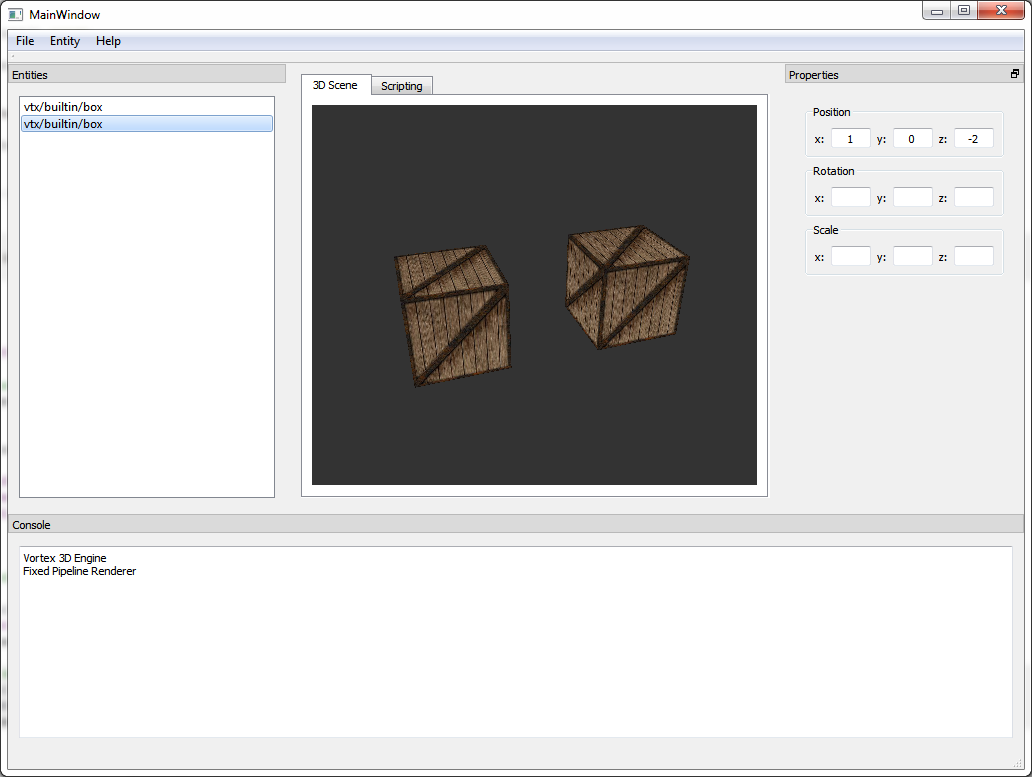Visual Editing of Transformations through the Vortex Editor UI
This week I started implementing the properties panel (sometimes called the “inspector” panel) for the Vortex Editor.

I originally wanted to go with a table design for the UI. I though it would give me the flexibility of adding as many editable entries as necessary. I even implemented a mockup in the UI that can be seen in previous screenshots of the Editor.
The problem that I found however was that both, the difference in font and text spacing, between the left and right panels of the UI made the layout look uneven. I knew I wanted something more symmetrical for what’s essentially the “home” view of the Editor, so I came up with a new design that can be seen in the image above.
Here, the Transform Panel consists in a custom UI component that is created dynamically and parented to the docked panel on the right. This provides a more uniform layout with two advantages: first, any number of property panels can be created and they will be nicely stacked one after the other in the panel (this will be useful in the future). Second, because the properties panel is detachable, it still allows the user to customize the Editor layout to her liking.
Now, one minor roadblock I’ve encountered from the engine standpoint for fully realizing this idea is the way Vortex currently represents Entity transformations.
All transformations in Vortex are represented as a 4×4 Matrix. The driving force behind this decision was to avoid having to convert between rotation representations at render time, thus saving some time down the line at during any scenegraph traversal passes.
So what does a generic transformation matrix look like in Vortex?
Matrices are a 4×4 list of values representing values in the homogeneous coordinate system:
In this matrix, (tx, ty, tz) correspond to the translation component of the Entity and we can easily extract this information to populate the Transformation Panel. But what happens with the rotation and scale?
Rotation and Scale are mixed in together in the matrix (represented by the overlapping sr components), so we can’t really extract the original scale and rotation that generated this matrix. This means that we will only be able to show and edit the position of the Entity and not its rotation or scale.
This is a limitation that has to be lifted.
The plan is to provide a higher-level contraption for describing transformations. Indeed a Transform class that will keep separate tabs for position, rotation and scale but will also provide a convenience method for computing on-demand the transform matrix that this transform represents.
A tentative interface for the Transform class could be:
namespace vtx {
class Transform
{
public:
void setPosition( float x, float y, float z );
void setRotationEuler( float rx, float ry, float rz );
void setScale( float sx, float sy, float sz );
vtx::Matrix4 matrix() const; // used for the rendering pass
// Other getter methods omitted
};
}
I think this will be a good change for the Engine. Working with Entities using a position-rotation-scale mindset instead of having to the deal with the cognitive overhead of thinking in terms of representing these as matrix operations will help users be more productive (and save precious keystrokes).
This coming week I will be working on finalizing this implementation and finally exposing full Entity transformation control through the UI. Stay tuned!